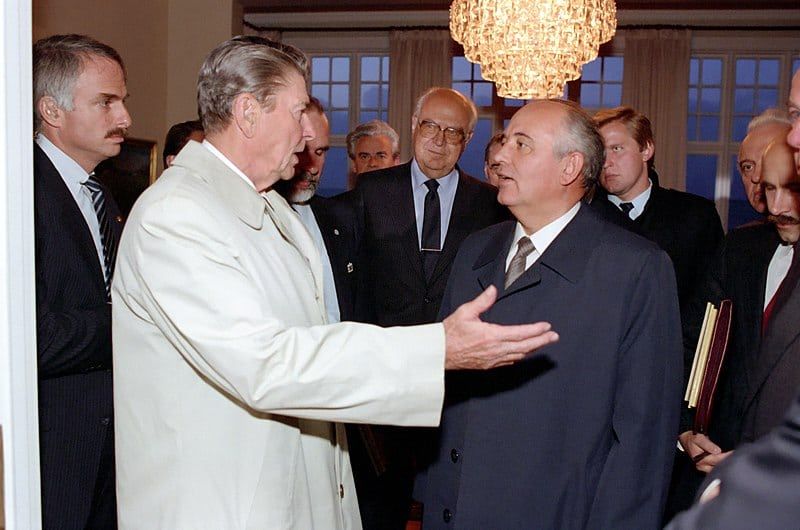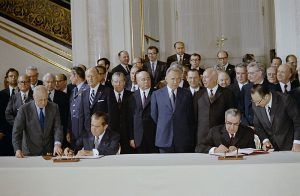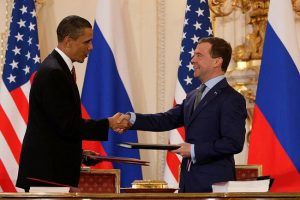The rise and demise of arms control
By Michael Krepon | November 15, 2021
 President Reagan says goodbye to Soviet General Secretary Gorbachev after the last meeting at Hofdi House Reykjavik Iceland in October 1986
President Reagan says goodbye to Soviet General Secretary Gorbachev after the last meeting at Hofdi House Reykjavik Iceland in October 1986
Arms control is much unloved at both ends of the political spectrum. Those ideologically opposed to arms control on the right believe it to be a snare and a delusion. In this view, arms control agreements confine US nuclear capabilities and are a poor substitute for freedom of action. Some on the left believe that arms control negotiations take too much time to accomplish too little, that it has been too patriarchal, and that focusing on arms control gets in the way of the pursuit of abolition. Both perspectives ignore how much has been accomplished by arms control in the past, including deep cuts in deployed forces, an end to nuclear testing, and most important, a norm against the battlefield use of nuclear weapons. Arms control has also produced essential but imperfect regimes against nuclear proliferation and the possession and use of chemical and biological weapons.
The remedies proposed from the right focus on strengthening nuclear deterrence. But deterrence has a track record of failure in lesser cases, and reliance on deterrence alone without arms control is a recipe for nuclear catastrophe. The remedy proposed by abolitionists is well beyond reach at present, when four pairs of nuclear-armed rivals—the United States and China, the United States and Russia, China and India, and India and Pakistan—seek to strengthen deterrence while embracing dangerous military practices. If we are to avoid nuclear war and to make headway toward abolition, there is no alternative to arms control. As nuclear dangers grow and as diplomacy has yet to find traction, a pragmatic reconsideration of the value of arms control is overdue. We have succeeded in avoiding nuclear war in the past by harnessing deterrence to arms control. If national leaders have enough foresight and wisdom, we can do so in the future, as well.
Dwight Eisenhower was the first president to internalize the realization that diplomacy needed to accompany deterrence, but his halting efforts to discuss surprise attack and nuclear testing with the Kremlin were hamstrung by the intensity of superpower competition and by mutual distrust. A progression of US and Soviet leaders—every one of them odd couples—then tried to accompany deterrence with some form of reassurance that the most threatening weapons in their arsenals would remain holstered. The combined pursuit of deterrence and arms control was awkward and difficult. One early head of the US Strategic Air Command, General Thomas Power, likened this to dressing and undressing at the same time.
At the beginning of the Cold War, nuclear deterrence was all about sharpening swords. The practice of arms control, which wasn’t conceptualized until early in the Kennedy administration, sought initially to deal with reciprocal fears of surprise attack. Both pursuits were premised on the need to avoid nuclear war, but their respective methods seemed as irreconcilable as the atmospheres of Mars and Venus, and their advocates usually operated at cross purposes. Early advances in arms control generated countermoves that intensified the nuclear competition, beginning with an agreement reached by John F. Kennedy and Nikita Khrushchev to stop nuclear testing in the atmosphere 10 months after the Cuban missile crisis. Nuclear testing then continued unabated underground.
Richard Nixon and Leonid Brezhnev began the process of establishing controls on strategic arms. Nixon and Henry Kissinger were deeply ambivalent about their major achievement—a ban on national missile defenses—but they were left with no alternative. The acceptance of mutual vulnerability codified in the Anti-Ballistic Missile (ABM) Treaty reflected reality. Missile defense technologies were utterly inadequate, the Congress was deeply divided over these deployments, and the Pentagon preferred to spend money on offenses. By agreeing to the ABM Treaty in 1972, Nixon and Kissinger removed one impetus to arms racing—the need to overwhelm defenses—but others remained.

The companion strategic arms limitation agreement that Nixon and Brezhnev signed—the 1972 “Interim Agreement”—did not control critical advances in land- and sea-based missiles. The Pentagon and the Soviet General Staff would have it no other way, and so the arms race continued full bore. Presidents Gerald Ford and Jimmy Carter tried to cap these arsenals, but both were stymied by domestic divisions and troubling Soviet behavior in far-away places.
Deep reductions became possible only with the pairing of Ronald Reagan and Mikhail Gorbachev, two visionaries with little regard for deterrence orthodoxy. Both men were abolitionists at heart. They believed deeply in nuclear peace. Reagan resolved that Armageddon would not happen on his watch. He envisioned a world in which nuclear weapons would become “impotent and obsolete” by means of futuristic defenses. Gorbachev, aware that the Soviet economy was groaning under defense expenditures, proposed a more direct route: defenses would not be needed if threats receded and if existing forces were slashed.
Their mutual commitment to abolition was on display at the 1986 Reykjavik summit, much to the discomfort of all Reagan’s advisers but one—Secretary of State George Shultz, who described these talks as the highest stakes poker game ever played. With abolition beyond reach, Gorbachev and Reagan settled on a treaty eliminating some missiles and laying the groundwork for fifty per cent reductions in others.
When George H.W. Bush became President in 1989, the stage was finally set to realize lasting conditions conducive to nuclear peace. Bush was empowered by Reagan and Gorbachev, who broke the back of the nuclear competition, by the collapse of the Soviet Union and the Warsaw Pact, by an accomplished team of advisers, and by Bush’s grounding of his predecessor’s visionary plans for strategic defenses.
After a short period of temporizing, Bush’s team—National Security Adviser Brent Scowcroft, Secretary of State James Baker, Secretary of Defense Dick Cheney, and Chairman of the Joint Chiefs of Staff Colin Powell—seized the opportunities in front of them. They completed negotiations on a treaty dramatically reducing conventional armament, another banning the possession and use of chemical weapons, and the Open Skies Treaty mandating cooperative overflights from Vancouver to Vladivostok. Two strategic arms reduction treaties were also completed on Bush’s watch, both enabled by a serious scrubbing of nuclear targeting requirements with Cheney’s complete support. At Cheney’s urging, Bush’s second strategic arms reduction treaty, negotiated just before he left office in 1993, eliminated land-based missiles carrying multiple warheads, the backbone of Soviet war-fighting capabilities.
Operating under conditions ripe for breakthroughs, Bush 41 accomplished more in four years in the pursuit of arms control and reductions than any other president. A lasting nuclear peace appeared to be at hand. The Cold War was over. A badly weakened Russia was a willing partner rather than an enemy. The habitual concerns of deterrence strategists about crisis, arms race, and strategic stability—where one rival could be badly disadvantaged by the actions of a competitor —were seemingly put to rest.
President Bill Clinton set about to secure Bush’s achievements and to pursue others, as well. During his administration, nuclear laboratories that once competed on warhead designs collaborated to improve the safety and security of Russia’s warheads and bomb-making material. Washington helped Moscow retrieve and dismantle Soviet missiles and warheads left behind in Ukraine and Kazakhstan, thereby enabling implementation of 50 per cent reductions in Bush’s first Strategic Arms Reduction Treaty. After an arduous ratification debate, Clinton won the Senate’s consent to ratify the Chemical Weapons Convention. He also secured the indefinite extension of the Non-Proliferation Treaty, negotiated in the Johnson administration with an initial duration of 25 years, while also completing negotiations on a treaty banning all nuclear weapon explosions.
The period of apogee for arms control lasted a decade, beginning with Reagan and Gorbachev’s high-wire act at Reykjavik and the initial Soviet acceptance of on-site inspections in 1986, and ending with Clinton’s first term in 1996. Then arms control stalled out, facing strong opposition from newly empowered Republican majorities on Capitol Hill and the absence of a partner in Moscow during Boris Yeltsin’s profoundly ineffectual second term.
Republican senators typically allow Democratic presidents one bite of the treaty ratification apple. Jimmy Carter succeeded with the transfer of the Panama Canal but faced stiff opposition on the second Strategic Arms Limitation Treaty—even before the Politburo’s rump decision to send troops into Afghanistan. Clinton labored to secure the Senate’s consent to ratify the Chemical Weapons Convention negotiated by Reagan and Bush. He then turned to the Comprehensive Test Ban Treaty, but momentum had already begun to shift against its entry into force. In 1998, India and Pakistan tested nuclear devices. The following year, Clinton was rebuked when seeking ratification of the treaty he described as the longest sought, hardest fought of all arms control measures. He failed to secure a bare majority of the Senators present and voting, let alone the required two-thirds.
Nuclear arms control was an integral part of the Cold War. Ironically, the conditions for its demise were in place when the Cold War ended. In particular, four building blocks for constructing the edifice of arms control started to erode badly after the dissolution of the Soviet Union and the Warsaw Pact.
The first building block was bipartisanship. As US power grew without a peer competitor, bipartisanship waned. The internationalist wing of the Republican Party began to atrophy. Some proudly waved the banner of America First. Republican presidential aspirants began to position themselves as teardown artists, taking aim at negotiated constraints as infringements on US freedom of action and sovereignty.
A second building block for the rise of arms control was the nominal acceptance of a rough balance of strategic offensive forces. John F. Kennedy was the last president to argue that a treaty (banning atmospheric tests) was worthy of the Senate’s consent because it would extend US superiority. After that, treaty making was justified as securing “sufficiency” (Nixon and Kissinger), “essential equivalence” (James Schlesinger), and other catch phrases.
This phraseology masked the twin quests endemic to deterrence of seeking advantage and seeking to avoid disadvantage—impulses hard to distinguish from the pursuit of dominance. With the demise of the Soviet Union, the twin engines of nuclear competition idled, at least temporarily. Thereafter, equality with Russia was a fiction; the only place where it remained was in the numbers associated with strategic arms reduction treaties. All the more reason, in the view of triumphalists, to ditch them.
A third building block for the rise of arms control was the acceptance of mutual vulnerability. This was the biggest irony of all during the Cold War: National vulnerability became, as Winston Churchill predicted, the uneasy basis for avoiding nuclear war. In 1972, the acceptance of mutual vulnerability, as codified in the ABM Treaty, won the support of all but two US senators.
Soon enough, the ABM Treaty became intolerable to most Republican office holders on strategic and moral grounds. After 9/11, Bush could discard the ABM Treaty without domestic political consequences. The Bush administration also dispensed with the classical tenet of strategic arms control that linked strategic offenses with defenses. Under Bush 43, the world’s sole superpower would decide how to defend itself against missile attacks, and decide, as well, on how much nuclear offense was enough.
A fourth building block for arms control was the acceptance of the inviolability of borders and national sovereignty, codified in the 1975 Helsinki Final Act recognizing a divided Europe. President Gerald Ford was hammered for his decision to accept the “captive” status of nations east of a divided Germany. In actuality, the Helsinki Final Act set in motion waves of engagement that helped loosen Moscow’s grip at home and within the Warsaw Pact.
All that became apparent later; of immediate consequence was that the inviolability of borders, once affirmed in the Helsinki Final Act, accelerated negotiations on European security and facilitated the Kremlin’s acceptance of confidence- and security-building measures, on-site inspections, and deep conventional arms reductions. This building block for arms control, like the others, didn’t survive Balkan wars and NATO expansion.
Cold War practices of arms control were thus on borrowed time when Vladimir Putin (2000) and George W. Bush (2001) took office. Nonetheless, the pace and scope of demise wasn’t foreordained; they were a direct consequence of the decisions both leaders made. Once the process of unravelling began, like the process of NATO enlargement, there were negative follow-on effects and few obvious stopping places.
Bush, unlike his father, had little interest in arms control, which he viewed as a relic of the Cold War. He presided over the Unipolar Moment, and he wasn’t inclined to haggle with the Kremlin. Instead, he was determined to exit from the ABM Treaty. His instincts were reinforced by those around him and by the national injury and trauma of 9/11.
Bush’s decision to withdraw from the ABM Treaty was barely debated, setting a pattern for major decisions to follow: Whenever Bush 43 felt strongly about the wisdom of a decision, no one around him fell on his or her sword. Vice President Cheney now viewed both the ABM Treaty and the ban on land-based missiles carrying multiple warheads that he helped engineer as dispensable. The need of the hour was to address painfully obvious vulnerabilities. Secretary of Defense Donald Rumsfeld agreed that arms control treaties were beside the point after 9/11, and National Security Adviser Condoleezza Rice chastised the “ayatollahs” of arms control for holding rigid beliefs. Secretary of State Colin Powell had qualms about withdrawing from the ABM Treaty, but they didn’t matter.
Putin, too, wanted freedom of action and chafed at treaty constraints. He couldn’t abide by the 1990 Conventional Forces in Europe Treaty which limited his ability to move troops and equipment on Russian soil to deal with domestic unrest in Chechnya and elsewhere. Putin plainly telegraphed that if Bush withdrew from the ABM Treaty, Russia would not ratify his father’s second strategic arms reduction treaty, as Moscow would need land-based missiles carrying multiple warheads as an insurance policy to counter prospective US national missile defenses.
Thus, Bush and Putin began unraveling the fabric of arms control woven during the Cold War at three corners. The process of demise that began by disregarding the Conventional Forces in Europe Treaty and by withdrawals from the ABM Treaty and the second Strategic Arms Reduction Treaty was slow to begin with, as Putin was in no position to reconstruct his armed forces quickly.
The immediate impact of Bush’s withdrawal from the ABM Treaty was negligible to begin with. Bush hurriedly deployed national missile defense interceptors in California and Alaska, but they were plagued with technical problems and were of no strategic consequence. To reinforce his view that the ABM Treaty was a relic of the Cold War and that the United States and Russia had no need to threaten each other, Bush announced his intention to cut deeply into US strategic forces. To further underscore his sincerity, Bush accepted Putin’s request to formalize bilateral reductions in abbreviated treaty form.
Relations between Bush and Putin were therefore decent, if not warm, at the start. Putin offered help after the 9/11 attacks and, for public consumption, Bush professed to peer into Putin’s soul, finding a straightforward and trustworthy partner. Putin was, however, accumulating grievances dating back to the Clinton administration’s actions to stop the bloodletting of Balkan wars. Clinton also opened the door to NATO expansion, and once the first invitations were extended to Hungary, Poland and the Czech Republic, other states quickly lined up awaiting entry.
Bush jettisoned Clinton’s cautious approach. His first tranche of NATO expansion in 2004 involved seven nations, including the three Baltic states. Other former members of the Warsaw Pact and former Soviet Republics lined up in the queue, and Bush crossed a bright red line in 2008 when he publicly endorsed—and a reluctant France and Germany reluctantly consented in principle to—the eventual inclusion of Georgia and Ukraine.
After the dissolution of the Soviet Union and the Warsaw Pact, Moscow measured disadvantage along two axes—US missile defense deployments and NATO expansion. Putin’s sense of national injury was compounded by Bush’s decision to deploy missile defenses on newly expanded NATO territory. As NATO expanded, the more arms control unraveled. Putin became more daring in violating treaties as the Russian economy rebounded, after Bush clarified his intentions to deploy missile defenses in Poland and the Czech Republic, and after signaling his intention to invite Georgia and Ukraine into the fold.
Putin aired his grievances in a sharply worded speech delivered in Munich in 2007, declaring that US interests had become immutably hostile. The following year, Russian troops threatened the capital of Georgia, effectively foreclosing its membership in NATO. More tellingly, Putin authorized the flight testing of a missile banned under the terms of the 1987 Intermediate Nuclear Forces Treaty, the landmark arms control agreement signed by Gorbachev and Reagan. Gorbachev overruled the wishes of his General Staff to retain some of these missiles for contingency purposes. Putin revoked the ban: if Bush could play by his own rules, he could, too.
Additional flight tests clarified the brazenness of this treaty violation. Putin also selectively violated two treaties negotiated by Bush 41 as the Cold War was ending — the Open Skies Treaty (in response to an egregious Polish overflight and NATO expansion) and the Chemical Weapons Convention (by using nerve agents against foes).
Then came Putin’s rejoinder to a popular uprising in 2014 against a thoroughly corrupt, Russian-backed leader in Kiev, after which he launched hybrid warfare in eastern Ukraine and in Crimea. Putin quickly arranged to annex Crimea, the first act of naked territorial conquest since the run-up to World War II. Ukraine, like Georgia, would not be joining NATO. In less than a decade’s time, US-Russian relations shifted from mutual positivism to mutual recrimination. Bush overreached badly and Putin pushed back hard once the Russian economy revived.
Bush’s successor, Barack Obama, entered office by endorsing the pursuit of abolition and with ambitious plans for arms control. This became known as the “Prague agenda” after a speech delivered there. Like Jimmy Carter before him, Obama’s plans yielded to hard geopolitical realities and to Republican opposition on Capitol Hill. His most significant achievement was to extend verifiable strategic arms control for another 10 years, a feat accomplished when Putin arranged the temporary transfer of the Russian presidency to Dmitri Medvedev.

Obama also made notable headway improving the security of bomb-making materials through a series of summit meetings. Obama was, however, a pragmatist as well as an idealist. When Putin reclaimed the presidency, his administration’s attempt to “reset” relations with Russia effectively ended. Obama turned his attention elsewhere, including the challenge of negotiating a nuclear deal with Iran. The Prague agenda withered, serving as a benchmark of unrealized expectations.
The pace of arms control’s demise again quickened with the pairing of Donald Trump and Putin. Trump was inclined toward tear downs and disinterested in the tedium of diplomacy. Putin, a serial treaty violator, shed crocodile tears as Trump announced US withdrawals from the Intermediate Nuclear Forces Treaty and the Open Skies Treaty. In all, Trump withdrew from four arms control compacts negotiated by his predecessors. His administration demonstrated scant interest in new arms control agreements and was opposed to deeper US reductions. Instead, he endorsed the idea of counting every US, Russian, and Chinese warhead.
Trump declined to extend Obama’s strategic arms reduction treaty, leaving verifiable strategic arms control on a ventilator, set to expire shortly after the inauguration of his successor—a transition he sought to block by fomenting insurrection. The two major proliferation problems Trump inherited became worse. He withdrew from Obama’s nuclear deal with Iran and engaged in vainglorious summitry with North Korea’s Kim Jong-Un. Iran then proceeded to shed inspections and limitations on fissile material production, while Kim ramped up his nuclear arsenal.
***
It’s easy now to forget how successful arms control was, despite painful setbacks along the way. So please remember this: It took just three decades after the enterprise of arms control, which was built from scratch in the Kennedy administration, to establish conditions for lasting nuclear peace. Deterrence alone, with all of its inherent dangers, accounts for no more than half of this success. Arms control was the greatest unacknowledged diplomatic accomplishment of the Cold War. The demise of arms control began when the Cold War ended. There were many reasons for the dismantling process, which became acute at the hands of Putin, George W. Bush, and Trump. They had other priorities and, without much thought to the future, cast aside accomplishments won with great difficulty and persistence. The rebuild will require another multi-generational effort, just like the original construction project. I’ve offered a road map for the rebuild in my book, Winning and Losing the Nuclear Peace: The Rise, Demise, and Revival of Arms Control. Reconstruction will begin once US, Chinese, and Russian leaders reach the same conclusion as leaders in Washington and Moscow during the Cold War—that nuclear deterrence is too dangerous to be left unattended by diplomacy. The revival of arms control is again needed to prevent mushroom clouds.
Editor’s note: Michael Krepon is the co-founder of the Stimson Center and the author of Winning and Losing the Nuclear Peace: The Rise, Demise, and Revival of Arms Control, from which this essay is drawn.
Together, we make the world safer.
The Bulletin elevates expert voices above the noise. But as an independent nonprofit organization, our operations depend on the support of readers like you. Help us continue to deliver quality journalism that holds leaders accountable. Your support of our work at any level is important. In return, we promise our coverage will be understandable, influential, vigilant, solution-oriented, and fair-minded. Together we can make a difference.
Keywords: ABM Treaty, Cold War, Reykjavik summit, arms control, disarmament, nuclear deterrence, nuclear history
Topics: Nuclear Risk, Nuclear Weapons














